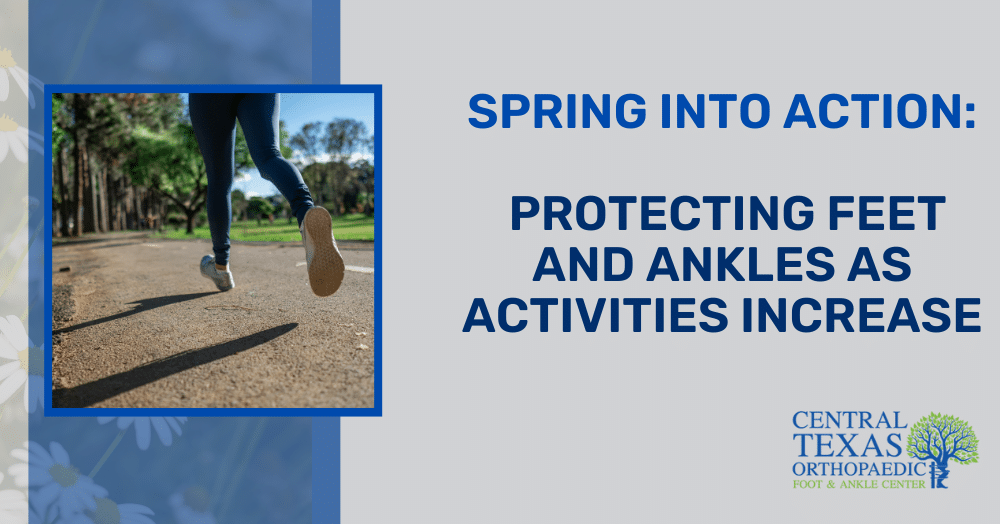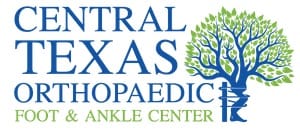Home » Uncategorized » Spring into Action: Protecting Feet and Ankles as Activities Increase
Spring into Action: Protecting Feet and Ankles as Activities Increase

It’s common to be less physically active in the cold-weather months; it comes with the cold-weather territory. But with warmer days and greening grass, outdoor activities start beckoning us outside.
On a suddenly 70° day in March, we may go on our first long jog of the season and play competitive soccer outside with the kids. But, there’s a payoff. The next day, our muscles ache, and our feet feel unreasonably sore. We may even be nurturing a sprain.
It’s beneficial to get outside as soon as warmer weather allows, but it’s equally valuable to remember that after a period of inactivity, exercising too rapidly can cause pain and injury.
So, how can we healthily spring forth into summer without stumbling towards injury along the way?
Common Springtime Foot & Ankle Injuries
To proactively avoid or to treat an injury, it’s important to be aware of common foot and ankle ailments and their symptoms.
Plantar Fasciitis
Inflammation of the plantar fascia, a band of tissue that runs along the bottom of your foot from your heel to your toes, is a common but painful condition.
Plantar Fasciitis can cause dull or acute heel pain, especially in the mornings, and the discomfort can make walking and other activities unpleasant to unbearable.
Plantar fascia tissue can become inflamed with sudden or continual overuse, which makes plantar fasciitis a common springtime injury.
Achilles Tendinitis
Achilles Tendinitis is irritation or inflammation of the Achilles tendon, which connects the bottom of the calf muscle to the heel bone.
Its primary symptom is pain along the back of the heel, and is caused by overuse or increased stress on the tendon.
Ankle Sprains
When the ligaments supporting ankle joints are stretched or torn, this creates a sprain. Symptoms include pain, swelling, and instability.
Ankle sprains are common in the spring because the muscles around the ankle might be weakened from winter inactivity.
Combating a lack of outdoor activities with routine indoor exercise protects from these injuries.
Shin Splints
Shin splints are defined as pain along the inner edge of the shinbone (tibia). This can be due to small muscle tears where the lower leg muscles attach to the tibia.
Like the other injuries listed above, shin splints are often the result of overuse/overtraining. They can also be caused by running on hard surfaces (springtime jogging or playing on the basketball court).
Assessing Appropriate Activity Levels
Anytime we take a break from physical activity, it’s important to work back up to previous levels slowly and steadily. We may have to build in a day or two for recovery in between activity sessions, too.
A sample progression plan focused on slowly increasing strength and endurance might include:
Weeks 1-2: Light activity (walking, basic aerobics, yoga, light weights) for short durations (15-20 minutes).
Weeks 3-4: A gradual increase in activity intensity and duration (30-45 minutes).
Weeks 5-6: A graduation to challenging activities requiring more strength and endurance, relative to individual fitness level.
Don’t Disregard Warm-Ups and Cool-Downs
It’s easy to overlook warm-up and cool-down routines. Many people focus on steps or calorie burn alone, forgetting that muscles that have a chance to warm up and cool down are less prone to injury.
Warm-ups gently increase blood flow and help prep muscles for movement. With increased strength and flexibility, this leads to a more effective workout.
Cool-down exercises also help with flexibility, while preventing blood pooling and reducing after-workout muscle soreness.
Sample warm-up and cool-down exercises for feet and ankles include ankle rotations, calf stretches, and toe curls.
Proper Footwear for Spring Activities
It’s tempting to wear the same tennis shoes to the grocery store, the gym, and kickball practice. They’re comfortable and well-worn. But, activity-specific shoes are the choice for sufficient feet and ankles.
Shoes designed for a particular activity offer exactly what is needed, for instance:
Running Shoes: Cushioning, support, and stability
Hiking Boots: Ankle support and stronger traction
Gardening Shoes: Protection, insulation from soil and moisture, comfort
Regardless of the activity-specific shoe you’re choosing, it’s always crucial to ensure proper fit and sufficient arch support.
When to See a Doctor
Symptoms warranting a visit to a foot and ankle specialist include persistent pain, swelling, instability, and changes in sensation. When in doubt, be sure to check it out! Early intervention keeps foot and ankle injuries from getting worse.
Our clinic is on standby. We can help you gain that spring in your step and assist you towards a fantastic year. Request an appointment today!

